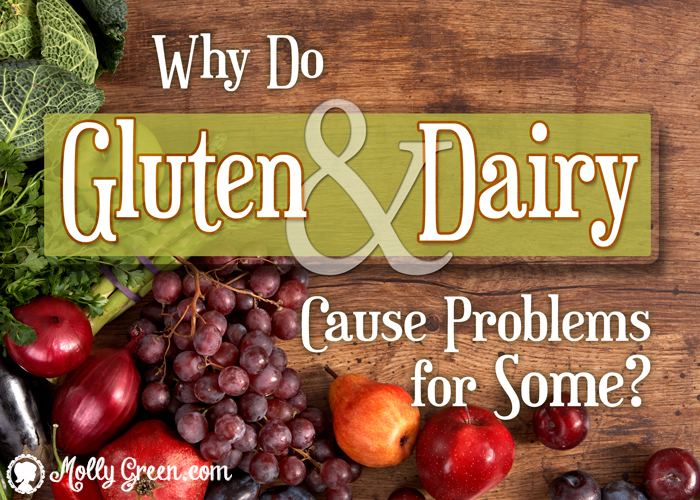By Terri Fites, MD
Armed with plenty of prescription and non-prescription medicines to treat our chronically stuffy, yet drippy noses; dry, chronic-hacking coughs; heartburn; headaches; and skin rashes, this two-doctor family continued blissfully unaware that our “healthy” yogurt and granola were fueling our family’s food intolerances.
Of course, our love of pizza and ice cream weren’t guiltless either. There was a point several years ago when I suspected a dairy intolerance, but at that time I had no idea that dairy (and gluten) proteins graced products like pre-chopped garlic and cold meat with their presence. Really? Milk in chopped garlic? Needless to say, in my ignorance, I did not sufficiently eliminate dairy for us to see results at that time.
Becoming a stay-at-home, homeschooling mom allowed me to devote more time to trying to get to the bottom of our symptoms. My research turned up gluten and dairy as two very pesky foods for people’s bodies to process. My family started our gluten and dairy elimination challenge which, I might add, ended up being very successful for us. I am often now asked about the two most common food intolerances.
What are they? Why are they problematic? How can I identify them?
The Two Most Common Food Intolerances
The two common food intolerances I see across homesteads are gluten and dairy. This may or not be surprising to you; these are the most common food intolerances throughout the United States, but since most of us grew up drinking dairy and consuming wheat bread, it can be hard to wrap your head around it.
So let’s break these two food intolerances down so you can better understand the symptoms and solutions to avoiding them.
First, let’s start with gluten.
What Is Gluten?
With the current trend, gluten might as well be branded with a skull and crossbones. But what really is “gluten?”
In general, glutens are proteins that a grain seed uses to store nutrients for seed germination and growth, and each kind of grain family has its own particular gluten. The gluten in wheat, rye, barley, and triticale are structurally similar and known to cause significant autoimmune disease in some people.
Wheat gluten is made up of two main troublesome proteins, gliadin and glutenin. Rye’s troublesome gluten is called secalin, and barley’s is called hordein. Most grains do not contain these disease-causing glutens and the common grains corn and rice are thus termed “gluten-free.”
Oats also do not contain gluten, but gluten cross-contamination can occur during harvesting, transportation, milling, or processing. Functionally, wheat gluten is a sticky substance which binds baked goods and helps thicken sauces and gravies. It gives bread and cookies their fantastic texture.
Why Is Gluten or Wheat a Problem?
Despite the hype, gluten is not known to be a problem for everyone, although it is problematic for more than is accounted. There are three main categories of people who do not tolerate gluten.
Celiac Disease
Celiac disease is caused by an immune reaction to the gluten in wheat, rye, barley, and triticale and requires lifelong, absolute abstinence from gluten-containing foods.
Antibodies made against gluten attack the body, causing a devastating autoimmune disorder well known for attacking the small intestine and causing diarrhea, nutrient malabsorption, and weight loss but also eventually affecting other organs as well. Strangely, the occurrence of celiac disease is several times higher than it was sixty years ago, and the people who get it and how it shows up is changing too.
Elderly people are now being diagnosed for the first time and, in all age groups, symptoms such as anemia, infertility, irritable bowel syndrome, constipation, osteoporosis, joint pain, fatigue, rash, liver disease, thyroid disease, ADHD, and psychiatric disorders are showing up as sole indicators of celiac disease.
Unfortunately, many healthcare providers still think of celiac disease as a disease that occurs in a younger group of people who have stomach aches, diarrhea, and are malnourished and underweight. Because of this stereotype, celiac is underdiagnosed.
Non-celiac Gluten Sensitivity (NCGS)
NCGS has symptoms similar to celiac disease which will improve with gluten elimination, but it does not have the intestinal destruction and positive antibody tests. It is not autoimmune in nature. Symptoms such as headaches, “foggy” brain, mood change, ADHD, bloating, constipation, abdominal pain, joint pain, and rashes occur. It is quite a controversial diagnosis due to the fact that there is no lab test for it, and what really causes the symptoms is unknown.
Rather than just gluten, it may actually be caused by different factors in the questionable grains. However, it is undeniable that some patients clearly have improved symptoms when gluten products are eliminated despite a negative diagnosis of celiac disease.
Wheat Allergy
There is also a true allergy to wheat in which a person can have anaphylaxis and immediate death with exposure. People with wheat allergy can be allergic to different parts of the wheat grain, perhaps gluten or perhaps different proteins in wheat. For these people, being “gluten-free” may not be enough, as even some “gluten-free” products can still have non-gluten containing wheat derivatives.
What About Dairy Intolerance?
Dairy is any product that is produced from the milk of an animal, such as a cow or goat. Cheese, milk, yogurt, ice cream, cream, and butter are easily identified as dairy products. However, proteins derived from dairy products are also considered dairy: whey, lactose, casein, and others. Some products use dairy components and can cause problems for dairy intolerant people, such as margarine and non-dairy creamers! Soy milk, almond milk, and rice milk are not dairy products, and typically do not contain dairy components.
Dairy Food Intolerances
Dairy Intolerance
Dairy contains many proteins which can present problems. A dairy intolerance is not life-threatening but can lead to many diverse sensitivity symptoms such as acne, headaches, asthma, stuffy noses, sinus congestion, inability to focus, diarrhea, and constipation. Common problematic dairy proteins, but not the only problematic proteins, are casein and whey.
Dairy Sugars
In addition to pesky proteins, dairy has the sugar called lactose. If lactose is not broken down properly in the small intestine, then people can have significant gastrointestinal symptoms such as bloating, gas, and diarrhea. The majority of adults do not digest lactose properly.
True Dairy Allergy
Finally, people can also have a true allergy to dairy and its derivatives and go into anaphylaxis and die with exposure.
How to Identify Gluten and Dairy In Foods
Gluten and dairy have many disguised names which are tricky to identify. They creep into things like cold meat, soy sauce, or beef bouillon cubes which is why label-reading is important. Every label needs to be read, every time, looking for the phrases “gluten-free” or “dairy-free,” observing the allergen warnings often included on packaged foods, and also reading the actual ingredient list. Companies change formulations without noting it on the front of the box sometimes, so it is important to check every single time.
Fresh fruits, fresh vegetables, and plain fresh meat (not boxed, processed, or seasoned in any way) should not have gluten or dairy. If you make them the staples of your diet, rather than processed foods, prepared foods, and grain-based foods, you will have an easier time remaining gluten-free and dairy-free. Venturing into boxed foods or prepared foods brings much-needed caution.
To remain truly gluten- and wheat-free, you need to investigate and find a complete list of words that indicate wheat and gluten content. Here is just a sampling, but not an inclusive list:
- Wheat, rye, barley, or triticale
- Malt and anything with the word malt in it
- Graham flour
- Hydrolyzed wheat protein
- Modified wheat starch
- Beer
Dairy is the same way with many covert terms:
- Butter, butter flavor, butterfat
- Casein or caseinate
- Cheese
- Milk protein
- A word which starts with “lact-,” such as lactalbumin and lactose
- Whey
Seek Help When Eliminating Gluten and Dairy
Doctors discourage people from going gluten- and/or dairy-free before medical consultation because elimination can complicate diagnosis and can lead to nutrient deficiencies. If you are going to attempt dairy and gluten elimination for you or your children, it is strongly recommended that you do so under the guidance of your physician. Proceed with the green light of your physician, being diligent in rooting out gluten or dairy. For us, even a little exposure brought back gastrointestinal symptoms in the beginning.
And finally, the best course of action is not to incorporate gluten- and dairy-free processed foods into the diet to replace old foods, but to try to include more vegetables, fruits, nuts, and meats to replace the gluten and dairy products.
Dr. Terri Fites, married seventeen years to her high school sweetheart, is a medical doctor and homeschooling mother of four. She graduated with honors first with her pharmacy degree from St. Louis College of Pharmacy, then with her medical degree from Indiana University School of Medicine. She teaches chemistry for her local homeschool co-op and blogs about the role of nutrition and environment in health at TheHomeschoolingDoctor.com.








We aren’t the only ones who are passionate about the best produce.